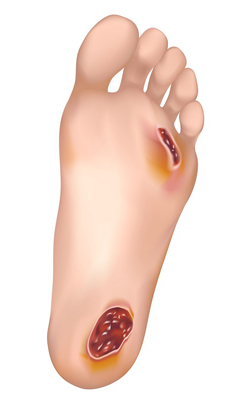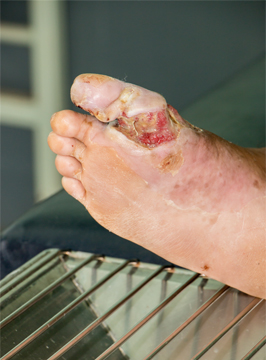Skip to content
Diabetic Foot Ulcers and Complications Advanced Wound Care Plano TX – Dr. Hina Rizvi M.D, C.W.Sadmin2021-11-18T18:02:44+00:00
Diabetic Foot Ulcers and Complications
- Diabetes can lead to many different types of foot complications, including athlete’s foot (a fungal infection), calluses, bunions and other foot deformities, or wounds and ulcers that can range from a surface wound to a deep infection.
 Longstanding high blood sugar can damage blood vessels, decreasing blood flow to the foot. This poor circulation can weaken the skin, contribute to the formation of ulcers, and impair wound healing. Some bacteria and fungi thrive on high levels of sugar in the bloodstream, and bacterial and fungal infections can break down the skin and complicate ulcers.
Longstanding high blood sugar can damage blood vessels, decreasing blood flow to the foot. This poor circulation can weaken the skin, contribute to the formation of ulcers, and impair wound healing. Some bacteria and fungi thrive on high levels of sugar in the bloodstream, and bacterial and fungal infections can break down the skin and complicate ulcers.- More serious complications include deep skin and bone infections.
- Gangrene (death and decay of tissue) is a very serious complication that may include infection; widespread gangrene may require foot amputation.
- Approximately 5 percent of men and women with diabetes eventually require amputation of a toe or foot. This tragic consequence can be prevented in most patients by managing blood sugar levels and daily foot care.
- Elevated blood glucose levels over time can damage the nerves of the foot, leading to neuropathy decreasing a person’s ability to notice pain and pressure. Without these sensations, it is easy to develop callused pressure spots and accidentally injure the skin, soft tissue, bones, and joints.
- Over time, bone and joint damage can dramatically alter the shape of the foot. Nerve damage, also called neuropathy, can also weaken certain foot muscles, further contributing to foot deformities.

- Patients who have had a previous foot ulcer are more likely to have future foot complications.
- Nerve damage, poor circulation, and chronically high blood sugar levels also increase the likelihood of foot complications.
- It is important to wear shoes that fit well. Shoes that are too tight can cause pressure ulcers. Going barefoot, even in the home, should be avoided as this increases the risk of injury to the foot.
- People with type 1 diabetes for at least five years should have their feet examined at least once a year. People with type 2 diabetes should have their feet examined once per year.
- During a foot exam, a healthcare provider checks for poor circulation, nerve damage, skin changes, and deformities. An exam may reveal decreased or absent reflexes or decreased ability to sense pressure, vibration, pin pricks, and changes in temperature.
- Special devices, including a monofilament or tuning fork, can help determine the extent of nerve damage. A monofilament is a very thin, flexible thread that is used to determine if a patient can sense pressure in various areas of the foot. A tuning fork is used to determine if a patient can sense vibration in various areas, especially the foot and toe joints.
- Some simple clues can point to circulatory problems. Poor pulses, cold feet, thin or blue skin, and lack of hair signal that the feet are not getting enough blood.
- Nerve damage may lead to unusual sensations in the feet and legs, including pain, burning, numbness, tingling, and fatigue.
- Nerve damage may cause no symptoms as the foot and leg slowly lose sensation and become numb. This can be very dangerous because the person may be unaware that they have improperly fit shoes, a rock or other irritant in a shoe, or other problems that could cause damage… read more
Page load link
 Longstanding high blood sugar can damage blood vessels, decreasing blood flow to the foot. This poor circulation can weaken the skin, contribute to the formation of ulcers, and impair wound healing. Some bacteria and fungi thrive on high levels of sugar in the bloodstream, and bacterial and fungal infections can break down the skin and complicate ulcers.
Longstanding high blood sugar can damage blood vessels, decreasing blood flow to the foot. This poor circulation can weaken the skin, contribute to the formation of ulcers, and impair wound healing. Some bacteria and fungi thrive on high levels of sugar in the bloodstream, and bacterial and fungal infections can break down the skin and complicate ulcers.


